If the Buffalo Pound Water Treatment Corporation receives a federal grant this year, it could freeze the capital water rate it charges Moose Jaw and Regina for potentially the next 25 years.
The corporation developed its 2021 operating budget using last year’s budget as a template, which had reduced operating costs after implementing pandemic-related safety measures but increased water sales since it was a dry year, explained general manager Ryan Johnson.
Since the budget forecasts a reduction in water sales this year, the organization will increase city water rates by 1.41 per cent, to $360 per megalitre (ML) from $355 per ML. Furthermore, it increased the city capital water rate by 16.28 per cent, to $250 per ML from $215 per ML.
In total, the corporation is charging Regina and Moose Jaw $610 per ML this year, which is an increase from $570 per ML — or 7.02 per cent — from last year.
“The capital water rate was developed assuming we receive positive news from the federal and provincial governments about the ICIP (Investing in Canada Infrastructure Program) grant, but we will have to finance whatever is leftover,” Johnson said during the Jan. 11 executive committee meeting while updating city council about the water treatment plant’s operations.
Increasing the capital water rate by 16 per cent should be the last rate increase for at least 25 years since that hike has helped the corporation reach sustainable water rate levels after starting at zero per cent five years ago, he continued. Meanwhile, the overall increase of 7.02 per cent for water rates might seem high, but the board expects that rate to remain under the consumer price index for the next quarter-century.
“I just think that that’s important for the new council and for the community to understand where our water comes from and what is required in order to get it to sink and other things we use,” said Mayor Fraser Tolmie.
The provincial government has talked about releasing water from Diefenbaker Lake so the water treatment plant can use that liquid, said Coun. Crystal Froese. She wondered if those conversations were still occurring, especially since Buffalo Pound Lake faces algae blooms.
While progress is occurring on that file, there are still unknowns and few details, said Johnson. The board is unsure whether there is a direct value to the water treatment plant to acquire water from Diefenbaker Lake based on the available information.
“Buffalo Pound Lake is a poor source of water. Diefenbaker is much better,” he continued. “But the amount of chemical we would save in treating Buffalo Pound water versus Diefenbaker (water) is very little. There might be $100,000 per year in savings. While that’s good, there will be other costs.”
If the water were piped to the plant, there would be benefits for only five months, since winter would affect the system the other seven months, Johnson added. While there might be benefits to Moose Jaw receiving water from Diefenbaker Lake, those same benefits are unlikely to extend to the water treatment plant.
2021 budget
The Buffalo Pound Water Treatment Corporation’s operating budget projects revenues this year at $13 million — with Moose Jaw contributing $1.8 million — and expenses at $12.9 million, leaving a projected surplus of $11,600.
On the capital side, revenues are expected to be $85.3 million, including $1.268 million in sales from Moose Jaw, $16.3 million from the ICIP grant and $60 million from a loan.
The corporation expects to sell 5,075 ML to Moose Jaw this year, while Moose Jaw is expected to use 617,000 kilowatt hours (kWh) in electricity.
Last year, the company had revenues of $13.1 million and expenses of $11.9 million, leaving a surplus of $1.14 million that was transferred to the operating reserve.




